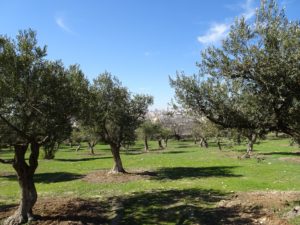WHAT REALLY HAPPENED IN HOLY WEEK?
Sunday and Monday
Right now we are at the start of Holy Week, the eight days when the worldwide church celebrates the last eight (or six) days of Jesus’ life. In fact, no one gives it much heed. Even in the churches, the prescribed readings are all about Jesus’ arrest and crucifixion. So what did in fact happen? Luckily, the Gospel of Mark gives us the lowdown.
(If you want to know why I think that Mark ’s account is reliable, see my blog on ‘Can we trust Mark’ in my Bible blog on bibleinbrief.org).

Jerusalem from the garden of Pater Noster Church, the Mount of Olives
SUNDAY (Palm Sunday) – Mark 11.1-11
Jesus and his twelve main disciples had just come, on foot, from Jericho. An 18 mile journey in the hot sun. When they were got to the Mount of Olives and could see Jerusalem across the steep valley of the river Kidron. Jesus sent a couple of disciples to the next village with instructions and a secret password to ‘liberate’ a young donkey and bring it back to him.
(Was this a coded message? Dorothy Sayers wrote a series of brilliant radio plays ‘The Man Born to be King’. In them she suggests that there were thousands of revolutionaries waiting to stage an armed uprising with Jesus at the head. They had a warhorse ready and waiting . If Jesus chose the donkey, he was rejecting the way of violence. They might then have said, “You’re on your own buddy.”)
Jesus got on the donkey and entered Jerusalem surrounding by an adoring crowd. At Passover time there were perhaps as man as two million pilgrims camping on the Mount of Olives, many from Galilee. (A high priest counted 25,000 lambs sacrificed at Passover and assumed each fed ten people. from Josephus ‘the Jewish War’). They were thrilled to have their local boy entering the holy city in style and they supported him all the way.
Jesus went into the temple and looked around. It was very impressive. The Holy Place was covered in gold and was bindingly bright in the sun. The outer court, the Court of the Gentiles, had an area of at least a sixth of the entire city. It was governed by the Sadducees, a priestly caste with a lot of influence and a lot of money, and pretty rough on anyone who got in their way. But Jesus did not do a thing. The High Priest and his allies must have heaved a sigh of relief.
By now it was quite late, and Jesus went down and up the Kidron valley to the village the disciples had got the donkey from. After their long walk they must have slept really well.
MONDAY – Mark 11.12-19
The next morning, on their walk into the city, Jesus spotted a flourishing fig tree. Although it was too early in the year for there be any figs, he made a great show of looking for them, and when he could not find any, he said “May no one ever eat fruit from you again.” What did he mean?
Then he entered the temple, i.e. the enormous Court of the Gentiles, and drove out those who were selling, he overturned the tables of the money-changers and the seats of those who sold doves (for sacrifice). (Money changers were those who exchanged normal imperial coins, which everyone used, for special temple ‘holy’ coins at a percentage!) And Jesus stopped anyone using the various gates of the temple as a short cut for carrying though trade goods. In other words he posted four to six burly Galileans at each of the temple gates whose function was to say to those who tried it on, “You don’t really want to come this way, do you?”
Jesus stayed there all day. Only when everything was winding down in the evening did he and his disciples go back to their base in Bethany.
What happened on Tuesday? Don’t miss tomorrow’s blog!
